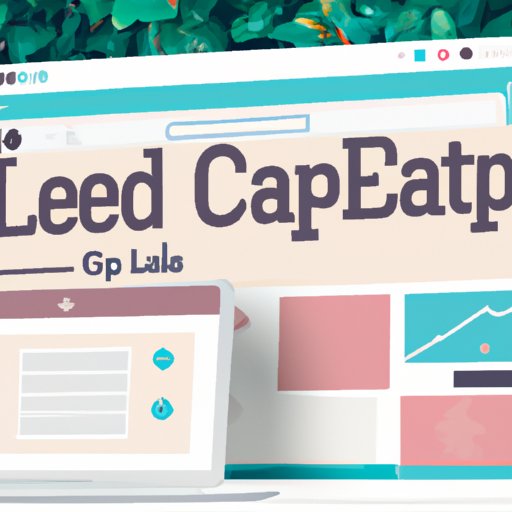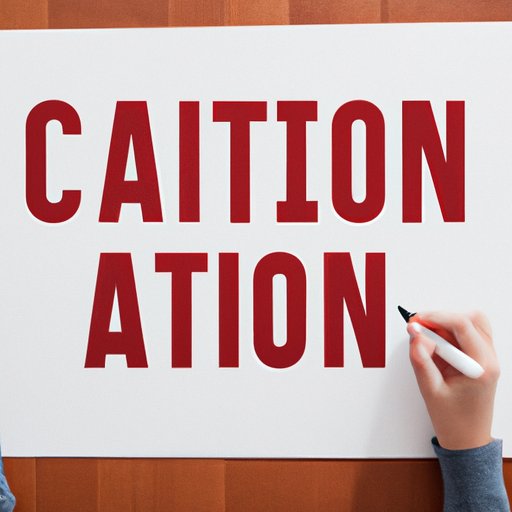Introduction
A lead capture page is a landing page used to capture leads by collecting contact information such as name, email address, and phone number. Creating an effective lead capture page is an important part of any digital marketing strategy as it helps businesses to engage potential customers and build relationships with them. In this article, we will explore what makes a good lead capture page and discuss the key elements, design principles, and strategies that can be used to improve lead capture pages.

Analyzing the Elements of an Effective Lead Capture Page
Understanding the goal of a lead capture page is the first step in creating an effective one. The purpose of a lead capture page is to collect contact information from potential customers and build relationships with them. To achieve this goal, there are several elements that need to be included on the page. These include a headline, call to action (CTA), form fields, and visuals.
Headline
The headline is the most important element of a lead capture page as it is the first thing people see when they land on the page. According to research conducted by Marketing Experiments, headlines are responsible for 80% of a page’s success. Therefore, it is important to craft a headline that captures attention and conveys the value of responding to the CTA.
Call to Action
The call to action (CTA) is the second most important element of a lead capture page, as it encourages visitors to take action. CTAs should be clear, concise, and action-oriented. For example, “Sign up now” or “Get started today”. Additionally, CTAs should be visually distinct from other elements on the page, so they stand out and are easy to spot.
Form Fields
Form fields are used to collect contact information from visitors. It is important to keep the number of fields to a minimum, as too many fields can be off-putting and cause visitors to abandon the page. Generally, the only information you need is name and email address, but you may also want to ask for a phone number if it is relevant to your business.
Visuals
Visuals are a great way to make a lead capture page more engaging and increase conversions. Images, videos, and illustrations can help to convey the message of the page and draw attention to the CTA. Additionally, visuals can be used to illustrate the benefits of responding to the CTA, which can be a powerful motivator for visitors.
Exploring Design Principles for Lead Capture Pages
Design plays an important role in creating an effective lead capture page. When designing a lead capture page, it is important to ensure that the page reflects the overall branding of the business. This includes using the same fonts, colors, and images that are used elsewhere on the website. Additionally, it is important to incorporate whitespace into the design to make the content easier to read and understand.
Another key design principle for lead capture pages is ensuring that the page is responsive and optimized for mobile devices. With more and more people accessing websites from their phones and tablets, it is essential to make sure that the page looks good and functions properly on all devices. This includes resizing images and minimizing the number of form fields to ensure the page runs smoothly on smaller screens.

Crafting a Compelling Call to Action
In order to get visitors to respond to the CTA, it is important to write copy that is clear, concise, and action-oriented. Copy should focus on the benefits of responding to the CTA, rather than just listing features. Additionally, persuasive language can be used to motivate readers, such as “Don’t miss out on this opportunity” or “Start now and get instant access”. Lastly, the CTA should be visually distinct from other elements on the page, so it stands out and is easy to spot.
How to Use Color Psychology to Enhance Lead Capture Pages
Color psychology is another key element of creating an effective lead capture page. Different colors evoke different emotions, so it is important to choose colors that create the desired feelings. For example, blue is often associated with trust and security, while red is associated with urgency and excitement. Colors can be incorporated into visuals, as well as the CTA button, to create the desired emotional response in visitors.

Writing Copy That Engages and Converts
When writing copy for a lead capture page, it is important to craft a headline that captures attention and conveys the value of responding to the CTA. The body copy should be simple and easy to read, focusing on the benefits of responding to the CTA. It is also important to highlight the benefits of responding to the CTA, as this can be a powerful motivator for visitors.
Utilizing A/B Testing to Improve Lead Capture Pages
A/B testing is a useful tool for improving lead capture pages. A/B tests involve creating two versions of a page, which are then tested against each other to determine which version performs better. When running A/B tests, it is important to identify what aspects of the page to test, such as the headline, copy, or visuals. Once the tests have been set up and run, the results can be analyzed and used to make improvements to the page.
Strategies for Optimizing Your Lead Capture Pages for Mobile Devices
It is essential to optimize lead capture pages for mobile devices. This includes ensuring that the page layout is mobile-friendly and resizing images to fit the smaller screen. Additionally, it is important to minimize the number of form fields, as too many fields can be off-putting and cause visitors to abandon the page.
Conclusion
In conclusion, creating an effective lead capture page is an important part of any digital marketing strategy. To create an effective lead capture page, it is important to understand the goal of the page and identify the key elements, including a headline, call to action, form fields, and visuals. Additionally, design principles, color psychology, and copywriting tips should be taken into consideration. Finally, A/B testing and mobile optimization should be utilized to improve the page and maximize conversions.
(Note: Is this article not meeting your expectations? Do you have knowledge or insights to share? Unlock new opportunities and expand your reach by joining our authors team. Click Registration to join us and share your expertise with our readers.)
